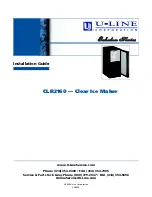13
ESL User Manual
2.
Go to the Setup-window of the ESL server application and press the
Delete database
button
to delete the generated database files:
dbase.csv
and
scan.csv
.
3.
(Optional) If you
ʼ
ve manually linked any ESLs using the sample database or want to redo the
linking of all ESLs, then press the
Delete links
button to delete the link file (
linked.csv
). Before
closing the Setup window, delete any existing links from the barcode terminal as well by using
4 settings
>
1 Delete Data
to prevent any links from being resent by the terminal.
After deleting the necessary files and closing the
Setup
window, the system will automatically
start detecting any incoming CSV files in the configured
Input folder
again. (See chapter 4).
3.3 Designing the ESL image layout
Probably the most important step in the customization process of the ESL system is determining
the design and format of the images that should be displayed on the ESLs.
When designing the layout of an e-paper ESL it
ʼ
s important to know the limitations of what can
and what can
ʼ
t be displayed.
The main characteristics are:
•
Fixed resolution of 200x96 pixels
•
Monochrome images only (black/white)
•
No anti-aliasing can be used on fonts (limiting the amount of available fonts)
•
Monochrome company logos and other product (group) images can be added to the layout.
•
Barcodes can be added using data of CSV database
•
Texts can be rotated only in 90° angles (currently only horizontal is supported in this version)
•
Dynamic texts, using information from the database, can be added and aligned as desired.
•
Different templates for groups of ELSs is possible by adding objects to the template using
logical conditions (i.e. condition:
ʻ
field x
ʼ
(group) equals
ʻ
5
ʼ
)
Currently, the layout of an ESL image is specified using a template file, which is XML-based.
Using very basic XML tags, it is possible to manually edit the included example template. Default
location of the template is
./Templates/Image.xml
.
Detailed instructions on how to edit the XML-based image template file can be found in
Appendix
A
.


















